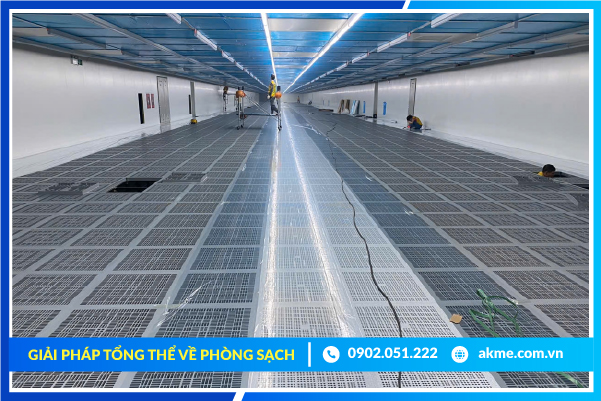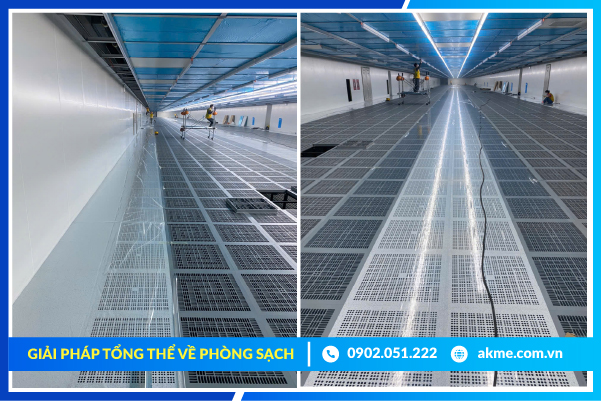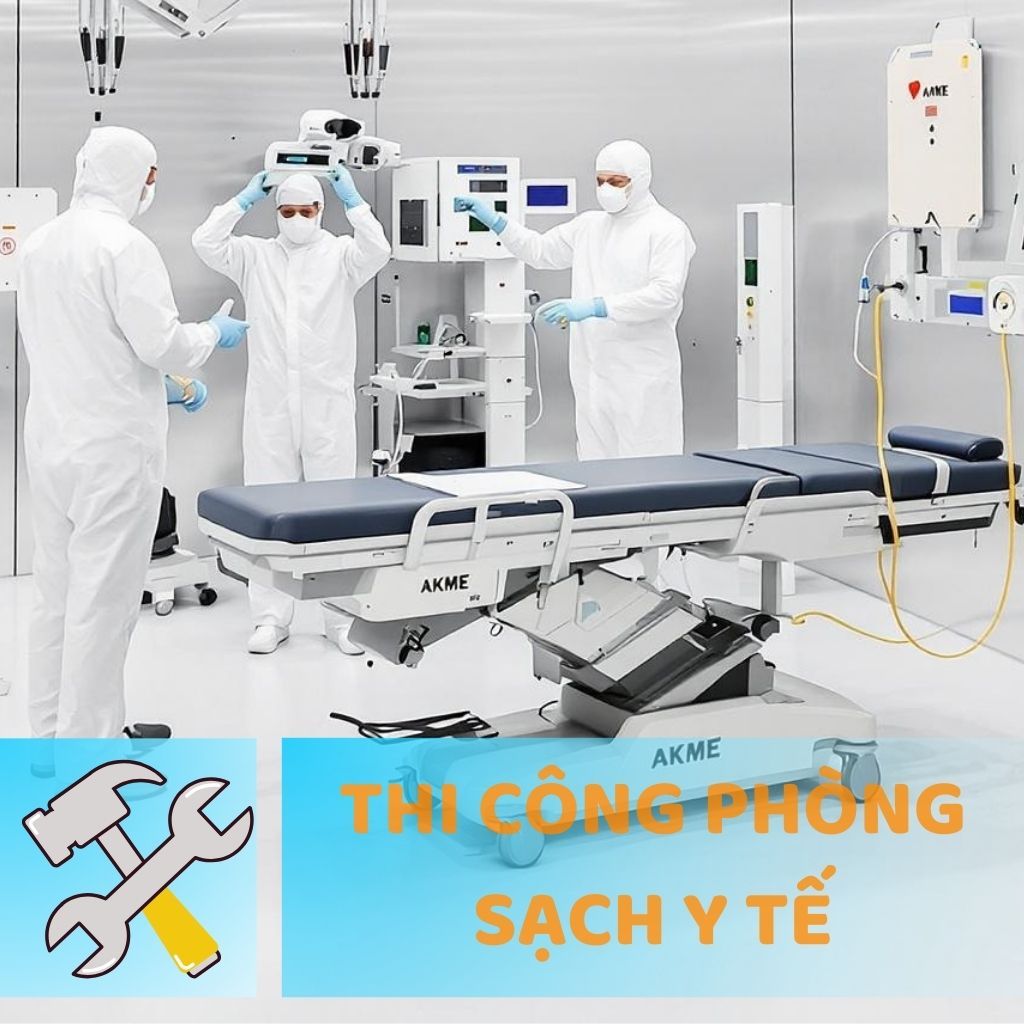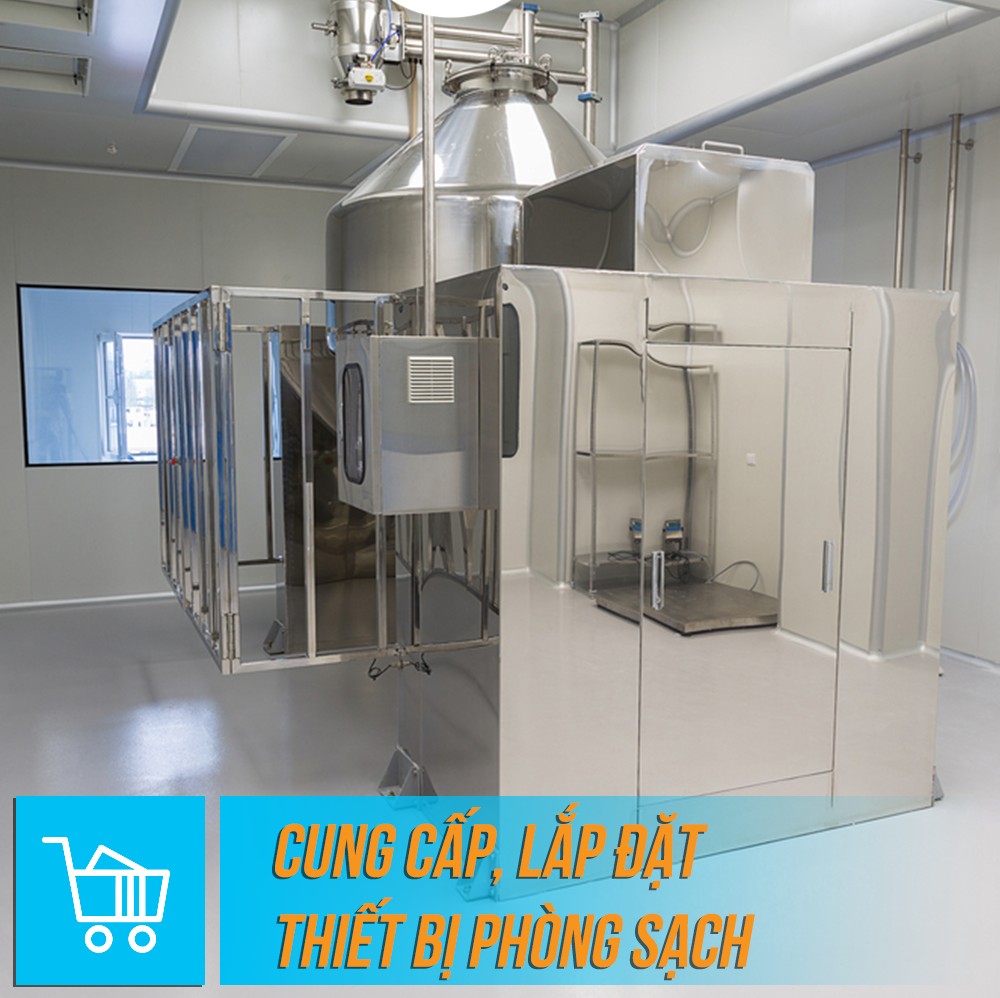Decoding Raised Floors in Cleanrooms for Electronics Manufacturing Plants
15:09 - 17/04/2025 940
Decoding Raised Floors in Cleanrooms for Electronics Manufacturing – Structure, ISO 14644-1 Standards, Flooring Materials, and GMP-Compliant Installation Methods
BMS system in a clean room
Controlling pressure differentials in cleanrooms.
In the era of high-tech manufacturing, electronics factories not only require modern production lines but also cleanroom-compliant environments. One of the core elements that help maintain these conditions is the raised floor in cleanrooms. This article will help you decode raised floors in cleanrooms for electronics factories, from structure and functions to installation standards.
Why are raised floors needed in electronics factories?
In environments producing electronic components, even the tiniest dust particles or static electricity can damage products. Raised floors not only enable proper airflow circulation but also:
- Conceal electrical wiring to prevent disorder and damage.
- Create space for the underfloor air return system.
- Support ESD devices to prevent static and protect components.
Therefore, constructing raised floors in cleanrooms is a must in high-tech factories.

Structure of raised floors in electronics factories
A standard raised floor system includes:
Floor panels
Usually Galvanized Steel raised floor panels or HPL raised floors, which have the following features:
- Good load-bearing capacity.
- Moisture and chemical resistance.
- Flat surface, easy to clean dust and debris.
Support frame and pedestals
Made from galvanized steel or stainless steel, adjustable in height. This is the main load-bearing component and determines the floor's stability.
Underfloor electrical and grounding system
Includes:
- Concealed wiring.
- Grounding wires under the floor connected to the anti-static system.
- EPA static control devices installed underneath to ensure safety for all electronics.
 Do raised floors affect air filtration efficiency?
Do raised floors affect air filtration efficiency?
The answer is YES. Raised floors help:
- Create a buffer zone for air to move from ceiling to floor, then be returned to the central filtration system.
- Stabilize airflow in a laminar pattern, preventing reverse dust flow into production areas.
- Enhance filtration efficiency, contributing to maintaining ISO 14644-1 and GMP EU cleanroom standards.
Common types of raised floors today
Depending on usage and technical requirements, the following types of raised floors are available:
High-tech raised floors
Used in electronics factories, fully integrated with wiring, gas regulation, and ESD systems.GMP-compliant raised floors
Applied in high-tech pharmaceutical and food manufacturing facilities.Light-duty raised floors
Used in office areas without heavy equipment.
Cleanroom raised floor standards
A compliant raised floor must meet the following:
- Minimum load capacity of 1000kg/m².
- No particle generation from collisions or prolonged use.
- Easy to clean and free from residue retention.
- Materials must not chemically react with cleaning agents.
- Surface resistance must meet ESD cleanroom requirements.
???? To meet these standards, many factories choose raised floors from Huiya Floor, a reputable brand specializing in cleanroom flooring.
How to install raised floors correctly
Step 1: Detailed design
Includes layout of electrical wiring, panels, air extraction zones, and air return locations under the raised floor.
Step 2: Prepare the base floor
Must be perfectly level, clean, and dry.
Step 3: Fix support frame and pedestals
Use laser levelers. Each pedestal should have an anti-slip base plate.
Step 4: Install floor panels
Ensure tight joints with no dust-trapping gaps.
Step 5: Check grounding
Ensure resistance is <10⁶ ohm, enabling effective ESD equipment operation.
???? Refer to the article “GMP-Compliant Cleanroom Installation Process” for more detailed steps.
How to test raised floor load capacity
Since heavy equipment like control cabinets and robots move over the floor, it must be strong and non-deformable.
Testing procedure includes:
- Apply 1000–1500kg load to the center of a panel for 24 hours.
- Observe sinking, sagging, or deformation.
- Measure the force required to cause failure (crush load test).
???? Learn more in “How to Choose the Right Raised Floor Material for Cleanrooms” to select suitable flooring based on load and function.
Differences between cleanroom and office raised floors
Criteria | Cleanroom Raised Floor | Technical (Office) Raised Floor |
Purpose | Control dust and static | Simple cable and HVAC routing |
Sanitation Standard | ISO 14644-1, GMP certified | No special requirement |
Surface Material | HPL, vinyl, Galvanized Steel (ESD) | Typically laminate or carpet |
Grounding System | Yes, connected to ESD | Not included |
Is it mandatory to use raised floors in electronics factories?
Yes, if:
- The factory produces micro-components like chips, ICs, displays.
- Cleanroom level ISO 7 or higher is required.
- SMT lines or automation robots are installed.
Not mandatory, if:
- The factory performs simple machining with no strict dust/static requirements.
However, to align with “smart factory” trends, most new plants are designed with high-tech raised floors from the start.
Optimal raised floor solutions for electronics factories
To optimize cost and performance, businesses should:
- Select flooring suitable for equipment, machine density, and foot traffic.
- Routinely inspect and maintain grounding, frames, and panels.
- Prefer products with international certifications such as ISO, FDA.
>>Read more: ISO 14644 standards to understand the latest global technical requirements.
Conclusion
Decoding Raised Floors in Cleanrooms for Electronics Manufacturing helps clarify the critical role of raised floors in high-tech facilities. Beyond technical benefits, they ensure compliance with international standards for cleanliness, safety, and static control.
Selecting the right flooring, proper installation, and regular inspections will help businesses cut costs, boost productivity, and maintain product quality.
???? Contact our experts for tailored raised floor solutions for your electronics plant!
For consultation – design – cleanroom installation, please contact:
 | ANH KHANG CLEANROOM ELECTROMECHANICAL JOINT STOCK COMPANY Hotline: 1900 636 814 - 0902 051 222 Email: info@akme.com.vn Website: akme.com.vn Address: Lot B7 - Xuan Phuong Garden - Phuong Canh - Nam Tu Liem - Hanoi |
12:05 - 28/11/2019 47511
Cleanroom Design and Construction
14:05 - 11/03/2025 20110
GMP and ISO Standard Cleanroom Construction
14:18 - 11/03/2025 12038
ISO Standard Medical Cleanroom Construction
14:13 - 28/02/2025 23019
Electronics Cleanroom Construction
16:15 - 18/03/2021 4608
Warranty Service
16:26 - 28/11/2019 17639
Supply and installation of cleanroom equipment
14:50 - 26/11/2019 5962
Technology Production Line Consulting
16:35 - 19/03/2025 18228














